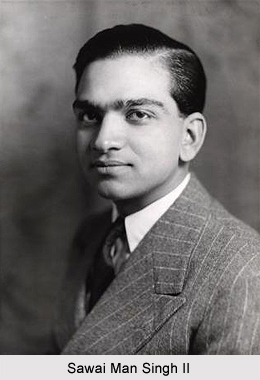 Sawai Man Singh II as Yuvraj of Jaipur succeeded his father Sawai Madho Singh after his death. Sawai Man Singh as the Yuvraj spent a major time in England during which period he gained training in military knowledge at the Royal Military Academy, Woolwich. Man Singh sailed from Bombay (now Mumbai) along with his elder brother and Colonel Twiss. Besides military education Man Singh developed a keen interest in the game of Polo which was one of his favourite games. He also continued developing connections with one of his close friend the Raja of Barwaras. It was during this period that Man Singh developed the sense of differentiating between responsibilities and fun. In England Man Singh was commonly known as Jai by his close friends.
Sawai Man Singh II as Yuvraj of Jaipur succeeded his father Sawai Madho Singh after his death. Sawai Man Singh as the Yuvraj spent a major time in England during which period he gained training in military knowledge at the Royal Military Academy, Woolwich. Man Singh sailed from Bombay (now Mumbai) along with his elder brother and Colonel Twiss. Besides military education Man Singh developed a keen interest in the game of Polo which was one of his favourite games. He also continued developing connections with one of his close friend the Raja of Barwaras. It was during this period that Man Singh developed the sense of differentiating between responsibilities and fun. In England Man Singh was commonly known as Jai by his close friends.
On his return to India he got alarmed with some issues of social backwardness which became his main orientation. A major issue was female child infanticide, especially in rural villages. Along with this the young Yuvraj also took some prime initiative in organising the public works. As the society was still quite backward the prince had to take some moral steps to improve the general condition of the local rural people. Among his major public works he took up the issue of water supply as a prime concern. Under his orders the irrigation dam was constructed at Ramgarh which shall provide sufficient water supply to the surrounding areas. This was supplemented with the building up of some filtration plants which would supply clear drinking water to the people. As a Yuvraj he launched some such most important ventures in the public interest which were completed after he gained complete power as the Maharaja. In 1927 the electricity work was launched officially. Various administrative steps were also taken with regular payment of taxes and regular check up of the revenue department of Jaipur. All this gave complete knowledge of the kingdom which brought the Yuvraj much closer to the people.
During this period reshaping of army as well as internal police force of Jaipur was undertaken. These were originally divided into four separate quarrelsome sections which got reorganised into single units. This enhanced the security of the state both externally and internally. Along with some sound administrative and economic reforms were also made for the well being of the people. When in Jaipur Yuvraj Man Singh was also interested in introducing innovations in sports. While Polo had been his major attractions, hunting was equally exciting for him. He used to be accompanied by his friends and other local native princes in his expedition of hunting either tiger or panthers. Among this shooting a tiger was his biggest passion.
Sawai man Singh as the Yuvraj of Jaipur also went through his second marriage. As he was some of the most attractive good looking young prince of Jaipur he was approached by Sumer Singh, Maharaja of Jodhpur for a second time. This time he wanted his daughter to be married with Yuvraj Man Singh. The marriage was celebrated wit great pomp and show. His name, fame and glory reached all the corners of India. Along with Sumer Singh, Jiterdra of Cooch Behar from West Bengal also approached him for his daughter Gayetri Devi who became the most popular third prince of Man Singh. She is commonly known for her beauty and elegance.
Thus with some major administrative and economic reforms and public works Yuvraj Man Singh marked his presence just after returning from England. He was one the most prominent Yuvraj of India.



















